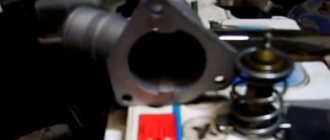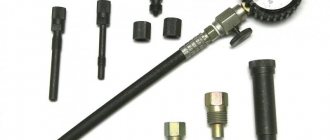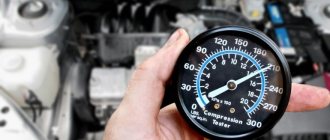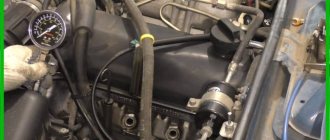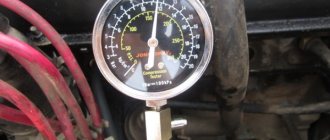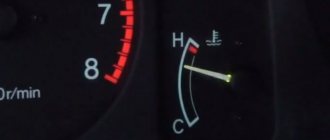Engine operating temperature on the VAZ-2110 - is there a difference?
Despite the fact that 8 and 16-valve VAZ engines have a slight difference in the design of the cooling system, the operating temperature for both engines is the same.
Engine operating temperature on the instrument panel.
The factory provides normal engine operating temperatures ranging from 87 to 103 degrees. Maintaining the temperature within these limits can be greatly influenced by certain issues related to the performance and quality of the cooling system elements. Let's look at each of them briefly.
Let's sum it up
In this article, we looked at one of the most common reasons why the engine does not heat up, may cool down while driving, the engine temperature does not exceed 70 degrees, etc. Thermostat previously set to cold. In parallel with this, other malfunctions of the cooling system may occur, as a result of which the internal combustion engine does not heat up.
It should also be noted that repairing the device is impractical due to its relatively low cost. For this reason, instead of descaling the thermostat and trying to clear the jam, it is better to immediately install a new element on the machine.
Operating temperature of VAZ 2110: diagnostics and replacement of the coolant temperature sensor
Drivers who regularly drive on country roads often see the following picture: a car is standing on the side of the road with the hood raised, and steam is coming from the engine compartment. The cause of this situation is most often the temperature sensor. In one case, the motorist himself is to blame for the breakdown; he did not notice the temperature increase, and in the other, the electronic element was worn out. The coolant sensor (DTS) rarely breaks, but if this happens, then urgent replacement is required. After studying this material, the reader will learn what the operating temperature of the engine is, why the VAZ 2110 engine gets hot, how to check the DTOZH and how to replace/install a new element in a car where the injector is located.
This happens if you do not notice a malfunction of the engine temperature sensor in time.
Sensor check
You will need a multimeter for the test. The coolant temperature sensor is checked as follows:
- The product is removed from the vehicle (the process is described in the removal and installation instructions in the next section). Next, you need to prepare a container completely filled with coolant;
Diagnostics of the coolant temperature sensor disassembled using a multimeter - Now you need to heat the container and place the coolant sensor inside, which was previously connected to the multimeter. The important point is that you need to know the temperature in the container to determine whether the item is healthy or not. The table will help with this. For example, if the tank temperature is 40°C, the resistance should be around 1459 ohms;
Table for determining liquid temperature using multimeter readings - If the operating temperature does not match the resistance (or vice versa), the element is faulty and requires replacement as it cannot be repaired. If the deviation is small, simply clean the sensor surface - this may solve the problem.
What should the engine operating temperature be?
Engine operating temperature shown on the instrument panel
If we take the information from the international convention of automobile manufacturers dated December 1, 1992, then the uniform standard for engine operating temperature is considered to be 90 degrees Celsius. With such indicators, the engine operates as efficiently as possible and does not create residual negative effects.
When switching to more advanced engine manufacturing technologies in 2004, it was accepted that a specific indicator of this indicator cannot be held in one position, and therefore they made a gradation of acceptable standards, which amounted to 85-105 degrees Celsius.
Engine overheating shown on the instrument panel
At this temperature, all systems function normally, and the motor is not subject to negative factors and consequences.
The engine cooling system has many components that are interconnected, and if one fails, the entire system will not be able to function. So, let's look at the location diagram and decoding of the indicators for the cooling system of a 16-valve engine.
Diagram of the cooling system operation
1 – heater radiator; 2 – steam removal hose of the heater radiator; 3 – outlet hose; 4 – supply hose; 5 – coolant temperature sensor (in the block head); 6 – pump supply pipe hose; 7 – thermostat; 8 – filling hose; 9 – expansion tank plug; 10 – coolant level indicator sensor;
11 – expansion tank; 12 – exhaust pipe; 13 – liquid chamber of the carburetor starting device; 14 – radiator outlet hose; 15 – radiator supply hose; 16 – radiator steam outlet hose; 17 – left radiator tank; 18 – sensor for turning on the electric fan; 19 – fan electric motor;
20 – electric fan impeller; 21 – right radiator tank; 22 – drain plug; 23 – electric fan casing; 24 – timing belt; 25 – coolant pump impeller; 26 – supply pipe of the coolant pump; 27 – coolant supply hose to the throttle pipe;
In fact, there are quite a lot of components in the cooling system that are susceptible to failure. This depends not only on the service life, but also on maintenance, as well as the quality of the parts. So, let's look at the main components, faults and methods for solving them.
Common Causes
As you know, the VAZ 2110 is equipped with two types of engines: with 8 and 16 valves. There are several main and most common reasons why such overheating of power units occurs.
- Low coolant level in the system
- Faulty thermostat
- Radiator cooling fan is faulty
- The temperature sensor of the power supply, etc. is faulty.
Let's look at each of the causes and solutions to these problems separately.
Engine tens
Low coolant level
Coolant plays a huge role in the operation of the cooling system. A special substance, namely antifreeze, is poured into the expansion tank.
Under normal conditions, the coolant level should be at the MAX mark on the tank body. This means the container is about 50-60 percent full.
If there is no such mark on the tank, use the clamp as a guide. The liquid should reach the top edge.
- If the engine is overheating, try adding the missing amount of coolant to the optimal level.
- If you haven't changed the coolant in a while, it's best not to add new coolant, but simply replace it completely with new coolant.
- When choosing between antifreeze and antifreeze, most VAZ 2110 owners prefer the former. And mainly due to the financial availability of antifreeze. But in practice, antifreeze is better. One of its most important advantages is that the substance does not freeze in severe frosts. For certain regions of our country, this is a key factor when choosing a coolant.
Thermostat
Another reason for engine overheating is a blocked thermostat valve. If it remains closed and does not open, the coolant will only move in a small circuit. As a result, this will lead to strong heating of the power plant. Overheating in itself can have very, very serious consequences.
Such a malfunction can appear at the most inopportune moment - on the road. You are unlikely to be able to carry out quality roadside repairs. But you can try one method - knock on the thermostat housing. This often allows the device to return to normal operation temporarily. This will help you get to the garage or the nearest gas station. The thermostat there has already been replaced with a new one. There's no point in fixing it. If he failed once, the situation will surely repeat itself soon.
Engine thermostat
temperature sensor
A temperature sensor is needed to respond to changes in engine temperature. When the set value is reached, the sensor is triggered and turns on the cooling fan.
If this device fails, the power unit will overheat because the fan does not work. As a result, the temperature does not drop below the critical level, but continues to gradually increase.
If you find such a problem on the road (most of the time the engine overheats in traffic jams, since the engine is running and there is no oncoming flow of cooling air), try to quickly get out of the traffic jam and find a free section of the road.
Accelerate in an open area, then begin engine braking. Then the temperature will drop and overheating will not occur. Under no circumstances should the vehicle be used regularly in this manner. But this is a great way to get to a garage or auto repair shop, determine the cause of the sensor failure, and then replace it.
Cooling Fan
The symptoms of a fan malfunction are similar to a non-working temperature sensor. That is, the engine will warm up, the indicator on the instrument panel will be in the red zone.
Again, it is recommended to use the engine braking method while driving. So, let's go to the garage. Let the car cool down. In the meantime, go shopping for a new fan. This device for the VAZ 2110 costs about 600 rubles.
Fan problems
Other reasons
There are other, no less popular reasons for engine overheating. Therefore, we suggest that you familiarize yourself with each one in our table.
| Cause of overheating | Solution |
| Coolant level too low | Add coolant to the required level, focusing on the marks or on the clamp on the expansion tank |
| Radiator clogged or clogged | Flush the radiator. If this does not help, you need to replace the disk |
| The cooling system pump is faulty (the impeller slips on the internal shaft) | Better to replace the pump |
| The oil level in the lubrication system is critical | Add oil to the required level. If it is old, change the oil |
| Incorrect ignition timing | Perform torque adjustment |
| Thermostat has failed | Replace the device with a similar new one |
| Cooling fan motor has failed | repairable, but it is better to install a new engine |
Airlock
In addition, an air lock in the cooling system can greatly interfere with the circulation of coolant.
A plug may occur after the liquid boils, as well as due to improper replacement of antifreeze or depressurization of the system. As a rule, air is removed from the cooling system through the throttle body pipe, as the highest point of the closed cooling system. After removing the plug, the engine will warm up to rated temperature and will not overheat.
Air is removed through the throttle body pipe after the engine has warmed up to operating temperature.
Thermostat
Most of the complaints are made specifically to the thermostat, the bypass valve, which directs the coolant in a full or small circle, depending on the degree of heating.
The engine may not warm up to the legal 87–90 degrees due to a stuck valve. But most often, thermostat malfunctions occur due to the quality of the thermoelement. Despite the fact that each thermostat is marked on the body, which indicates the valve response temperature, the indicated temperature does not always correspond to reality.
So, at the specified operating temperature of 85 degrees, the thermostat can pass liquid in a large circle already when warming up to 75–80 degrees. As a result, the temperature will not correspond to the norm, the engine will not be able to warm up to the optimal value. The only solution is to test the thermostat before installation. To do this, the thermostat body is placed in a vessel with water and heated to the specified temperature, periodically checking the condition of the valve. A discrepancy between the thermostat response temperature, even by 3–5 degrees, will not allow you to obtain the optimal operating temperature while driving.
kokika 26.11.2009 – 10:49
Auto VAZ 2110
The fan turns on constantly.
The needle goes into the red zone, there is a squeak (the onboard beeps or something), the fan kicks in, cools down to about 100 and then goes back to heating. Moreover, the car manages to heat up within 1.5 km, well, with a warm engine.
I bought the car used. 2007, a student myself, traveling around the city. I think it depends on my driving style.
Driving style, sometimes I drive sections of 35 km/h in 2nd gear, but mostly I drive in 3rd gear for 50 km/h. How many revolutions should you keep? Well, I always show 15 at 50 mph and 3rd gear (sort of).
Maybe it’s all normal, it’s just this squeak every time you turn on the fan (it’s like it’s not right).
I’m wondering if it’s zero degrees outside now, what will it be like in the heat.
I checked the antifreeze and showed it to the guys; 4 people said it was ok. Well, just in case, I’m posting (photos), I didn’t find any risks there.
What is your operating temperature?
So I always have 105 somewhere and every kilometer goes into the red, it cools down (by the fan) and again, is this how it should be?
PS: I defined the border of the red zone as 110 on the scale
Attached images
Post edited by kokika: 11/26/2009 – 10:53
QUOTE (kokika @ November 26, 2009, 10:49 am)
Auto VAZ 2110
The fan turns on constantly.
The needle goes into the red zone, there is a squeak (the onboard beeps or something), the fan kicks in, cools down to about 100 and then goes back to heating. Moreover, the car manages to heat up within 1.5 km, well, with a warm engine.
I bought the car used. 2007, a student myself, traveling around the city. I think it depends on my driving style.
Driving style, sometimes I drive sections of 35 km/h in 2nd gear, but mostly I drive in 3rd gear for 50 km/h. How many revolutions should you keep? Well, I always show 15 at 50 mph and 3rd gear (sort of).
Maybe it’s all normal, it’s just this squeak every time you turn on the fan (it’s like it’s not right).
I’m wondering if it’s zero degrees outside now, what will it be like in the heat.
I checked the antifreeze and showed it to the guys; 4 people said it was ok. Well, just in case, I’m posting (photos), I didn’t find any risks there.
What is your operating temperature?
So I always have 105 somewhere and every kilometer goes into the red, it cools down (by the fan) and again, is this how it should be?
PS: I defined the border of the red zone as 110 on the scale
Try to go out of town on a straight section and drive without traffic jams and observe. You can drive the same 50 km/h (of course they will swear, you are studying, it is advisable to choose a section that is not very busy), for example, on a weekend from Krasavinsky Bridge to Mulov (or vice versa), you can go further. You can go 50 km/h in fourth, even better. In winter (not in severe frosts), the stove saves you from overheating when the temperature is close to the red zone. a more powerful stove fan mode if it’s hot to open the window, and in severe frosts the stove already operates at higher speeds, and it’s not so easy to boil.
Post edited by expertaleks: 11/26/2009 – 11:53
Radiator cooling fan
Electric fan with casing removed
This part provides cooling of the liquid, but if there is insufficient oncoming wind flow, it is this part that additionally creates an air flow. The cooling fan prevents the temperature from rising to a critical level.
It turns on at 100 degrees Celsius, and turns off at 94.
Cat 302 11/26/2009 – 11:55
If you have an on-board vehicle, look at the temperature on it and everything will become clear!!!!
No one named what kind of work they should be?
And how much does diagnostics cost?
thank you in advance
And why is it dangerous to drive a little at a temperature of 110?
The car has two temperature sensors: 1 on the injector, the second on the dashboard
The readings from these sensors may vary.
The thermostat opens at 90-95 degrees.
After the engine warms up, the temperature is maintained within 96-103 degrees.
In your case, the thermostat may be faulty, this could be checked if you had an on-board computer by looking at the exact temperature readings when the thermostat was opened.
It’s better to go for diagnostics, besides this problem you can find out a lot of interesting things about your car.
Pipes
KIT kit of cooling system pipes
One of the main components of the cooling system, since it is through the pipes that the fluid circulates through the system.
The main malfunction is considered to be wear, namely the appearance of cracks and leaks of coolant. To fix the problem, you need to replace the damaged element.
Of course, it is recommended to change everything in sets, since it is unknown how many kilometers later another one will have to be replaced, and the process itself requires draining the coolant.
Engine temperature drops while driving
Experts strongly recommend that you inspect the vehicle before driving. Such visual diagnostics help to identify various deviations in its operation, allowing them to be quickly eliminated.
Particular attention must be paid to the indicators of the main systems, one of which is the operating temperature of the machine’s engine. It is displayed on the dashboard in the form of a small arrow display. Basically, motorists are faced with overheating of the power unit. Reverse deviations often occur when the driver notices that the engine temperature drops while driving.
Diagnostics using ODB-2 scanner
The general technical condition of the car can always be checked using a personal diagnostic car scanner. Among the options available on the market, we recommend paying attention to the Korean-made Scan Tool Pro Black Edition scanner. This model is perfectly compatible with most domestic and foreign cars.
A special feature of the device is full automatic diagnostics. Unlike analogues, this auto scanner is capable of diagnosing not only the engine, but also ABS, gearbox, transmission, airbag, air conditioning system, etc. All gauges, oil pressure, temperature and much more are available.
Extraneous noise
When extraneous sounds appear in engine operation, the first thing you need to do is look at the condition of the hydraulic compensators, since they are the most common cause of failure. The solution to the problem of knocking hydraulic valves is replacement. But if they have nothing to do with it, then it’s worth checking the oil pressure in the system. In addition, sounds may come from the pistons, their pins, main bearings or valves. If the problem is with them, then you should contact the nearest service center.
Troubleshooting a vehicle's fuel system || Refilling a car air conditioner
| Repairing a Nissan Almera engine is quite expensive, since Japanese spare parts themselves are expensive. The sooner you notice problems, the more likely it is that... |
Procedure. Step-by-step instruction
If after completing the next step the problem goes away, further checks are stopped.
- Open the hood.
- Wait for the engine to cool down.
- Perform an initial visual inspection: integrity of the hoses, reliability of the clamps, absence of leaks or cracks.
- Make sure that the expander cover elements are in good condition. Remove scale, rust, clear holes, wipe, assemble. The absence of noticeable damage to parts gives hope that the product will work.
The valve design is elementary. The cover contains a spring. Functionally, it is designed to regulate the pressure in the cooling circuit. A hot engine increases it, a cold engine decreases it.
Compressing at a value of 1.1 atmospheres, the spring relieves excess pressure and prevents the destruction of hoses and the tank. As the motor cools, it creates a vacuum effect. The tank will begin to flatten. The valve equalizes the pressure.
The lid screws tightly on the thread, eliminating distortions. There should be a gap between it and the body. An overtightened valve will not work. It is difficult to test the device's operation in road conditions. You can check by replacing it with a known good one.
Inspect the electrical wiring elements to ensure a reliable connection
Possible factors for damage to electrical circuits:
- vibration;
- oxidation;
- burning;
- breakage, fraying of electrical wires;
- insulation aging, short circuit.
Switch the tester to resistance measurement mode. Remove it with special tweezers and ring the fuse link F7 located in the mounting block.
Fuse box diagram
Replace the burnt-out element with a serviceable one with a rating of 20A. Inspect and clean the nest. Insert fuse.
It was not possible to find out the reason, the protection triggered again - look for a short circuit.
Disconnect the fan plug. Use a tester to measure the circuit of the electric motor windings. Zero resistance or a break indicate the need to replace the radiator blower electric drive.
Interturn short circuits that cause multiple replacements of fuse links cannot be measured with the device.
Sensor check
Start the car. Pull out the coolant temperature sensor connector. The fan starts working - the sensor needs to be replaced. Secure the disconnected wire. Drive to a nearby service station.
Relay test
There is a hatch on the floor at the front passenger's feet.
Below it is a built-in panel with three relays of the same type:
- fan installation;
- fuel pump;
- ignition (main thing).
By replacing each other, try to start the airflow. The VAZ 2110 fan does not work - go to the next step.
Check the electric motor
Winding measurements did not reveal a malfunction. Apply voltage briefly from the battery using additional insulated conductors. The operation of the fan indicates a malfunction of the controller, which does not output a signal to the relay.
- The only correct solution is to turn on the airflow directly and urgently visit a service station.
- Prevention of breakdowns of the cooling system of the VAZ 2110 injector 16 valves.
- Periodically inspect the components of the cooling system.
- Monitor the cooling temperature on the device, listen to the operation of the fan.
- Maintain coolant level. Replace after 2 years or 30,000 km.
- Use the solution to remove rust and scale.
- Signs of a change in the properties of the coolant are a change in color, an increase in fluidity.
- Check the density with a hydrometer.
- Do not mix coolants.
- Every twelve months, rinse the expansion tank cap with water and check it on a stand with a pressure gauge.
- Avoid contact of aggressive liquids with electrical wiring and electric motor windings.
conclusions
The operating temperature of the 16-valve VAZ-2112 engine is 87-103 degrees Celsius.
If this indicator increases, the engine may boil, which in turn can lead to serious negative consequences, such as bending of the cylinder head or major engine overhaul. It is worth carefully monitoring the condition of the components and parts of the cooling system, because they ensure normal cooling and operation of the power unit.
Didn't find the information you are looking for? on our forum.
Domestic 16-valve engines
A little preface. When faced with 16-valve VAZs at the household level, remember that such cars are always equipped with 14-inch wheels, since there are enlarged ventilated brake discs at the front.
So, the “gear” came from an 8-valve engine. In the articles you can find mentions that VAZ wanted to create a powerful and economical engine, and so, the “gear” will never be more economical than an eight-valve engine. Consumption 16 cl. engine 7.5 - 10 liters, depending on the dynamics.
The first engine from the line was 21120 (hereinafter referred to as the 120th
). The volume is one and a half liters, equipped with an ignition module, the valves bend. Visually different is the cast intake manifold. It was developed for cars 2110-2112, installed in various modifications such as “Premier” and 2112 in a two-door hatchback body. It went into production in 1996 and was installed on cars until 2004. If today you buy a car with such an engine, then most likely it has already undergone repairs and a “plug-in” piston is installed on it.
120th: valve bend, cast intake manifold, ignition module, 1.5 liters.
In 2004, the 120th engine was replaced by a new one with the index 21124 (hereinafter referred to as the 124th
). In addition to cars of the tenth family, it was installed on the VAZ 2113 and VAZ 2114.
This engine does not bend the valves, thanks to grooves on the pistons, this is its main difference from its predecessor. It is easy to distinguish by its plastic intake manifold. In addition, the ignition module has been replaced with individual coils for each cylinder. Engine capacity increased to 1.6 liters.
Many people call this engine the most balanced in the VAZ line, and I think this is true. Its service life is at least 200 thousand, if you drive “without fanaticism”.
124th: no valve bending, plastic intake, ignition coils, volume 1.6 liters.
In 2007, the tenth family left the assembly line (the vehicle kits were sent to Ukrainian as punishment) and the Priora was released. This “breakthrough” in mechanical engineering was equipped with the 21126 engine ( 126th
). It was equipped with lightweight connecting rods, pistons, liners, and other parts, which made its service life less than that of a 124 engine. In order to increase power, the grooves on the pistons have been removed and the valves on this engine are bent.
126th or “prioromotor”; oppression, lightweight, volume 1.6.
21128 or 128th
the motor was created and installed on Priora and 2110-2112, which were produced by this company. This is the heir to the 124th engine, the engine capacity has been increased to 1.8 liters, which has a negative impact on the service life. In practice, I saw one such car, which, with a mileage of 90 thousand kilometers, suffered from severe oil consumption. This engine received a lot of negative reviews.
Presentation of the 128th, source https://24techno-guide.ru/images/img575.j
In 2013, 21127 appeared or 127
-th engine, its power was increased to 106 horsepower, an adjustable air intake through the receiver was installed, the mass air flow sensor was abandoned in favor of the DBP (absolute pressure sensor) and the DTV (air temperature sensor). The valves in this engine are bent.
And the last creation we will look at is this 11194
engine. It has a volume of 1.4 liters, installed on Kalina. At one time I drove such a Kalina, and the meaning of such an engine is not clear to me; it drives exactly the same as an 8-valve one. The reviews leave much to be desired, and for its unjustified oil consumption, the engine was nicknamed the “legendary Kalinomotor”, of course, not without sarcasm.
We briefly looked at the "six" from VAZ. In this article I will not touch on modern Vest engines and other creations of AVTOVAZ; to be honest, I’m losing interest in studying the crafts of the alliance of the French and Japanese.
Sources
- zen.yandex.ru/media/tec/otechestvennye-16klapannye-motory-5da93b67028d6800ac761e55
- dvigatels.ru/russia/dvigatel-vaz-2112.html
- carprofy.ru/dvigatel/vaz-2112/
- drom.ru/catalog/lada/2112/specs/engine_capacity/
- drive2.ru/b/1827090/
